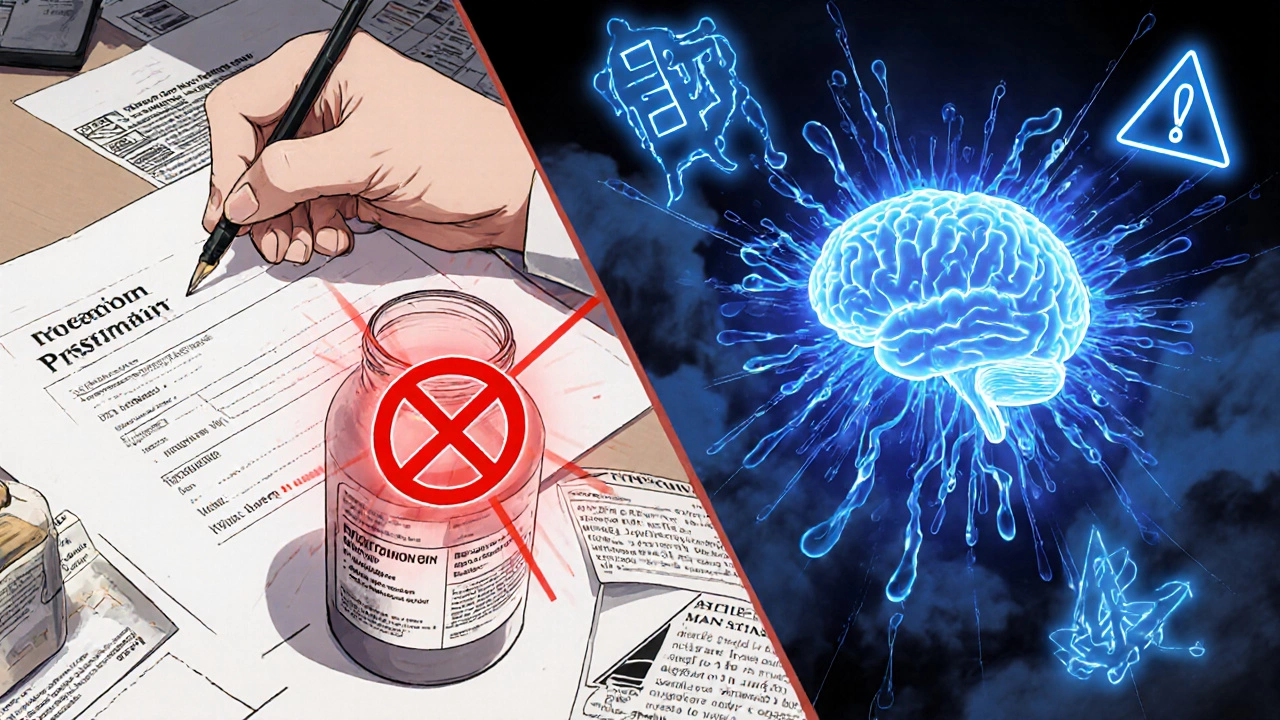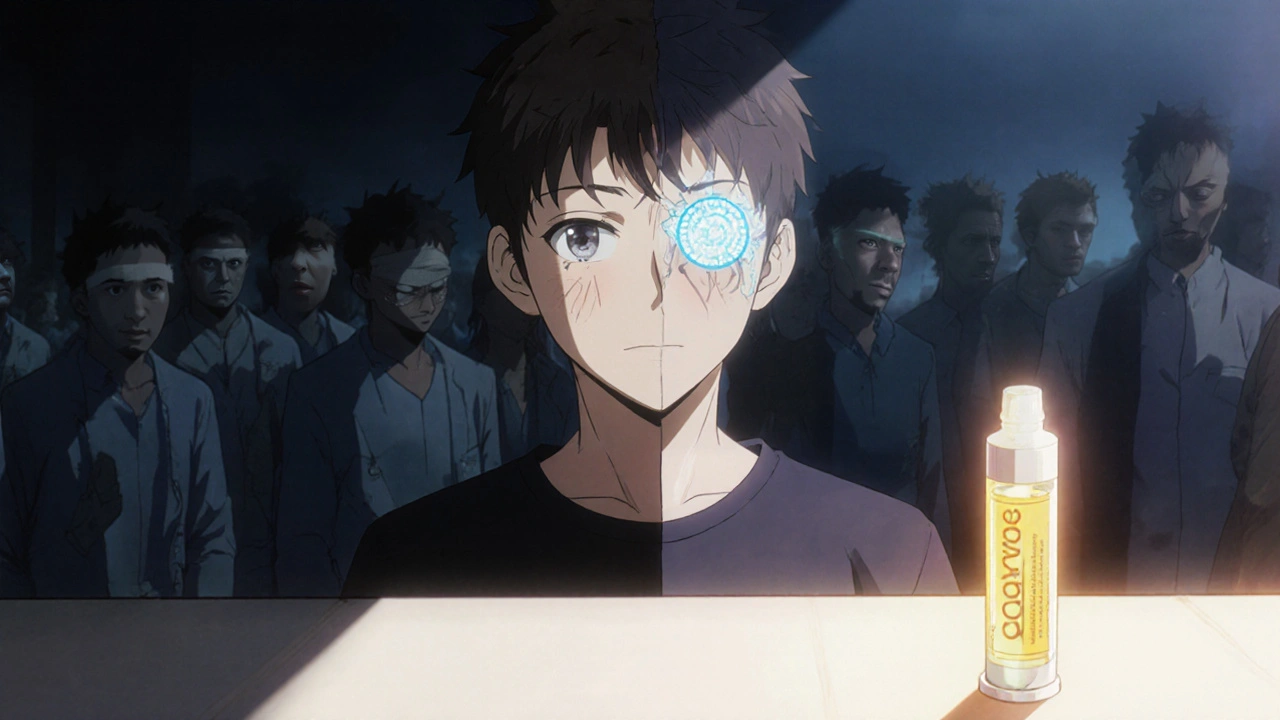Tetracyclines & Isotretinoin Interaction Checker
Check Your Medication Safety
This tool determines if you're safely taking tetracyclines with isotretinoin. Based on FDA warnings and medical evidence, some combinations can cause permanent vision loss.
What is pseudotumor cerebri?
This is a dangerous condition where pressure builds inside your skull, potentially causing permanent vision loss. It's not a brain tumor but a serious medical emergency.
Critical Warning
This combination is never safe and can cause permanent vision loss.
Both drugs multiply pressure in your skull. Doctors have reported hundreds of cases of vision damage from this interaction.
Safe to Take
Isotretinoin can be safely taken if you have not taken tetracyclines within the last 1-2 weeks.
Remember: You must wait at least 1 week after your last tetracycline dose before starting isotretinoin.
Most doctors recommend 2 weeks to be completely safe.
Always tell your dermatologist about all medications you're taking.
Safe to Take
Tetracyclines can be safely taken if you have not taken isotretinoin in the past week.
Remember: If you plan to start isotretinoin later, you must wait at least 1 week after your last tetracycline dose.
Most doctors recommend 2 weeks to be completely safe.
Always inform your dermatologist if you're taking tetracyclines for acne.
Important Safety Note
This tool is for informational purposes only. Always consult your doctor about medication safety. Never adjust your medications without medical supervision.
When you’re struggling with severe acne, it’s tempting to stack treatments-take an antibiotic to kill bacteria, and isotretinoin to shut down oil glands for good. But there’s one dangerous combo that doctors never mix: tetracyclines and isotretinoin. It’s not a mild side effect. It’s not a rare hiccup. It’s a known, documented, and potentially blinding interaction that has ruined vision in teenagers and young adults across the U.S. and Europe.
What Happens When You Mix These Two Drugs?
Both tetracyclines (like doxycycline, minocycline, or tetracycline) and isotretinoin (brand names like Claravis, Amnesteem) are commonly used to treat acne. Tetracyclines reduce inflammation and kill acne-causing bacteria. Isotretinoin shrinks oil glands and prevents clogged pores. Alone, each has risks. Together, they trigger a rare but devastating condition called pseudotumor cerebri-also known as idiopathic intracranial hypertension.
This isn’t a brain tumor. It’s when pressure builds inside your skull for no clear reason. The result? Crushing headaches, blurred vision, double vision, ringing in the ears that pulses with your heartbeat, and, in the worst cases, permanent blindness. The pressure builds because the fluid around your brain and spinal cord-cerebrospinal fluid-stops draining properly. And both drugs mess with that process, in ways that multiply each other’s damage.
The Science Behind the Danger
Isotretinoin is a powerful retinoid. It’s highly protein-bound and metabolized by your liver. Tetracyclines, especially doxycycline, slip easily through the blood-brain barrier. Alone, isotretinoin might cause pseudotumor cerebri in about 1 in 10,000 users. Tetracyclines alone? About 1 in 1,000. But together? The risk isn’t just added-it’s multiplied. Studies suggest the combined risk is at least 10 times higher than either drug alone.
Why? A 2023 study in the Journal of Investigative Dermatology found that when these two drugs are taken together, they sharply increase the production of a protein called aquaporin-4 in brain cells. This protein controls how fluid moves in and out of the brain. Too much of it? Fluid builds up. Pressure rises. Vision is at risk.
The FDA first warned about this in 1998. Since then, over 127 confirmed cases have been reported in their adverse event database. But experts believe fewer than 10% of cases are ever reported. Real numbers? Likely in the thousands.
Real People, Real Consequences
A 16-year-old girl in Ohio started doxycycline for acne. Two weeks later, her dermatologist added isotretinoin. After just 18 days, she lost peripheral vision. Tests showed elevated spinal fluid pressure. She underwent a lumbar puncture. Her vision improved-but not fully. Permanent damage remained.
On Reddit’s acne forum, users share stories like this one: “Took minocycline and Accutane for 10 days. Started seeing double. Went to ER. Diagnosed with pseudotumor cerebri. Had to stop both. Still have headaches.” These aren’t outliers. They’re predictable outcomes.
Dr. Zoe Diana Draelos, a top dermatologist at Duke, says: “We’ve seen permanent vision loss. This isn’t a theory. It’s a clinical reality.”
What Doctors Say-And What They Do
The American Academy of Dermatology, the European Academy of Dermatology, and the American Acne & Rosacea Society all agree: Never combine tetracyclines with isotretinoin. It’s a hard contraindication. Level I evidence. No exceptions.
Dr. James Q. Del Rosso, who helped write the AAD guidelines, puts it bluntly: “There is no safe window. The risk starts the moment you take both.”
And yet, a 2019 study found that nearly 4% of isotretinoin prescriptions were still being paired with tetracyclines-even after 25 years of warnings. Why? Some doctors forget. Some patients are prescribed tetracyclines for other reasons (like Lyme disease or respiratory infections) and don’t tell their dermatologist. Some patients switch from one drug to the other too quickly.

How to Stay Safe
If you’re on a tetracycline for acne-stop. Don’t start isotretinoin until at least one week after your last dose. Many clinics, like Mayo Clinic, recommend two weeks. Why? Because doxycycline can linger in your system for days. You need time for it to fully clear.
If you’re already on isotretinoin, avoid all tetracycline-class antibiotics. That includes:
- Doxycycline
- Minocycline
- Tetracycline
- Sarecycline
Even if you’ve taken one of these in the past year, tell your doctor before starting isotretinoin. Your pharmacist should flag this too-but don’t rely on that alone.
What About Other Acne Treatments?
You don’t need antibiotics to treat acne. And you don’t need to risk your vision.
For inflammatory acne, alternatives like dapsone gel (Aczone) are just as effective-and carry zero risk of pseudotumor cerebri. Topical retinoids (like adapalene) work well on their own. Spironolactone works for hormonal acne in women. And isotretinoin, when used alone, is the most effective long-term solution for severe cases.
In fact, since awareness of this interaction grew, isotretinoin prescriptions have risen 18% annually since 2015-not because more people are getting it, but because dermatologists are using it as monotherapy instead of pairing it with risky antibiotics.
Technology Is Helping-But You Still Need to Be Vigilant
Hospitals and clinics are catching on. Electronic health record systems like Epic and Cerner now have hard stops: if you try to prescribe isotretinoin while a tetracycline is active, the system blocks it. CVS Health’s pharmacy system now prevents dispensing this combo 98% of the time.
But technology isn’t perfect. Patients might get prescriptions from different doctors. They might refill an old tetracycline script while starting isotretinoin. They might not tell their pharmacist about all their meds.
That’s why you need to be your own advocate. Keep a list of every medication you’re taking. Show it to every provider. Ask: “Could this interact with my acne treatment?”

The Bigger Picture
This isn’t just about one bad combo. It’s about how we treat acne.
For decades, antibiotics were the go-to for acne. But overuse led to resistance. Now, we know they’re also dangerous when mixed with isotretinoin. The tide is turning. Dermatologists are moving toward non-antibiotic options. Dapsone gel prescriptions jumped 34% from 2018 to 2022. Topical treatments are getting better. And isotretinoin is finally being used as the powerful, targeted tool it was meant to be-without risky partners.
By 2030, experts predict tetracycline prescriptions for acne will drop another 40%. That’s not just good for antibiotic resistance. It’s good for vision. Good for lives.
What to Do If You’ve Already Taken Both
If you’ve taken tetracycline and isotretinoin together-even briefly-watch for these symptoms:
- Severe headaches, especially worse in the morning or when lying down
- Blurred or double vision
- Pulsing ringing in your ears
- Flashes of light or blind spots
- Nausea or vomiting with headache
If you notice any of these, stop both medications immediately and see a neurologist or ophthalmologist. A simple eye exam and lumbar puncture can confirm elevated pressure. Early treatment can prevent permanent damage.
Don’t wait. Don’t assume it’s “just a migraine.” This is neurological emergency territory.
Final Thought
Acne is frustrating. But it’s not life-threatening. The treatments we use should never put your vision at risk. This interaction isn’t a gray area. It’s black and white: never combine tetracyclines and isotretinoin.
If your doctor suggests it, ask why. If your pharmacy fills it, question it. If you’re on both, stop one and call your dermatologist. Your eyes are worth more than a few weeks of faster-clearing skin.
Can I take doxycycline and isotretinoin together if I space them out?
No. Even if you take them at different times of day or space them by hours, the risk remains. Both drugs affect brain fluid pressure, and their effects are synergistic. Experts agree there is no safe window. A minimum 1-week washout period after stopping tetracyclines is required before starting isotretinoin, and many clinics recommend 2 weeks.
Is this risk only for teenagers?
No. While the highest co-prescription rates are seen in teens (ages 12-17), adults are equally at risk. The mechanism affects all ages. Case reports include patients in their 20s, 30s, and even 40s. Age doesn’t protect you.
Are all tetracyclines equally dangerous with isotretinoin?
Yes. All drugs in the tetracycline class-including doxycycline, minocycline, tetracycline, and sarecycline-carry this risk. The interaction isn’t limited to one specific drug. Even newer tetracyclines like sarecycline, marketed as safer, still pose the same danger when combined with isotretinoin.
Can I take other antibiotics with isotretinoin?
Yes, but only non-tetracycline antibiotics. Erythromycin and azithromycin are considered safer alternatives, though they’re less effective for acne than tetracyclines. Many dermatologists now avoid antibiotics altogether and use non-antibiotic options like dapsone gel, topical retinoids, or spironolactone instead.
How common is pseudotumor cerebri from this interaction?
It’s rare overall, but significantly more common when both drugs are taken together. Isotretinoin alone causes it in about 0.02-0.1% of users. Tetracyclines alone cause it in about 0.1%. Together, the risk jumps to at least 1%-and possibly higher. With millions of acne patients treated each year, even a 1% risk means hundreds of preventable cases.
What should I do if I’ve already taken both drugs and now have headaches?
Stop both medications immediately. Contact your dermatologist and request a referral to a neurologist or neuro-ophthalmologist. Do not wait for symptoms to worsen. A lumbar puncture can measure spinal fluid pressure and confirm the diagnosis. Early treatment with medication or fluid removal can prevent permanent vision loss.
Is this interaction recognized outside the U.S.?
Yes. The European Medicines Agency requires explicit contraindication language in all isotretinoin product labels across the EU. The European Academy of Dermatology and Venereology calls this combination one of the few absolute contraindications in acne therapy. It’s a global medical consensus.

Sonia Festa
November 3, 2025 AT 12:32